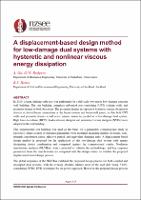| dc.description.abstract | In 2019, a large shaking-table test was performed for a full-scale two-storey low-damage concrete wall building. The test building comprises unbonded post-tensioning (UPT) rocking walls and perimeter frames in both directions. The perimeter frames incorporated hysteretic energy dissipation devices at slotted-beam connections at the beam-column and beam-wall joints, so that both UPT walls and perimeter frames would resist seismic action in parallel as a low-damage dual system. High force-to-volume (HF2V) lead-extrusion dampers and nonlinear viscous dampers (NVDs) were adopted in the test building.
This experimental test building was used as the basis for a parametric computational study in OpenSees, where a range of structural parameters are modified, including number of stories, wall-strength contribution ratios, effective period, and equivalent damping ratio. A displacement-based design method is proposed for the application of the low-damage dual system with energy dissipating device combination and compared against the computational results. Nonlinear time history analyses (NLTHAs) were conducted to validate the methodology, and key response parameters from the time-histories are compared with the design values, to validate the proposed displacement-based design process.
The global responses of the NLTHAs validated the proposed design process for both coupled and decoupled dual systems, with the average absolute relative error of the roof drift being 7.94%, considering NVDs’ EVD determined by the power approach. However, the proposed design process was shown to significantly underestimate the roof drift responses of the decoupled dual system when the wall strength portion was smaller than 0.7. | |

